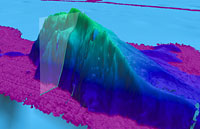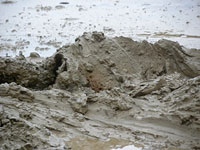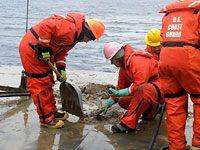

 | |||||||||||||||||||
|
|
Journals 2009/2010Jonathan Pazol
September 8, 2009 With much calmer seas, less wind, and more ice, our time on the ship has gotten more pleasant. We are no longer walking into doors and having problems balancing our trays in the mess, although once we leave the ice again, things could start getting interesting. So far, knock on wood, no seasickness, but I won't hold my breath. I did make 5 calls to Leyden today and got to talk to about 175 students in a variety of classes, which was great. They had excellent questions, and I will try to answer them in more detail in another Journal. But, as I was standing under the Aloft Conn with temperatures in the teens and a stiff wind, I was not happy to hear about 80° F and sun in Chicago - hopefully they will "save" some of that weather for me when I get home next week. In yesterday's Journal I described the preparation that goes into a dredging evolution (operation). Dredging sites are picked based on interesting undersea geological features, such as seamounts, that will give geologists clues into the ocean floor and its history. Chief Scientist Larry Mayer prepares a Fledermaus image (based on mapping data) and marks the spot for the dredge. Then, the ship is piloted to the right coordinates, the dredge is lowered, and the bow thrusters are turned on. This last step is done so that the ship can stay in place and not drift or get the dredge caught up on something.
What happens once the dredge comes back up is where the scientists and their helpers get involved. After about a 3-hour trip down to the sea floor, and 1-2 hours on the bottom (depending on conditions), the dredge makes its several hour trip back up to the ship. Once the tension in the winch wires has decreased, it is safe for people to help guide it back onto the fantail.
The dredge is then tipped over and the sediment (mud) and rocks are dumped onto the deck. Geologists Kelley Brumley and Alex Andronikov sort through the mud for rocks, while several of us are given other jobs. For this operation, Jennifer Henderson was designated as "Hose Girl" - her job was to rinse the mud off of any rocks. I was given the job of "Mud Boy" - as some of you (especially my students) are thinking, "If the shoe fits....." My job was to use a shovel to separate a section of the sediment, spread it out, and then help the geologists search through it.
The process was pretty messy, but if you like getting dirty, then I recommend geology as a career choice. Once we were done looking through the sediment and had picked out the rocks, it was my job to shovel the mud off the back of the ship - I guess my years working at a veterinary clinic have finally come in handy.
|
||||||||||||||||||




